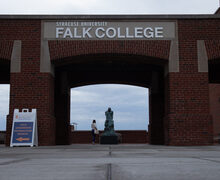Smart money: SUNY-ESF, five other universities receive joint $2 million grant to improve biomedical research
Illustration by Andy Casadonte | Art Director
The State University College of New York College of Environmental Science and Forestry, along with five other universities, received a joint grant of $2 million that will help scientists understand and treat diseases such as cancer, diabetes and AIDS.
The money, from the National Institute of Health, will pay for a new nuclear magnetic resonance spectrometer, which helps researchers examine molecules, said Gregory Boyer, chairman of the chemistry department at SUNY-ESF.
David Kiemle, the instructional support specialist at ESF, demonstrated the device after a news conference on Thursday with a spectrometer ESF already owned.
The spectrometer, which was taller than Kiemle, resembled a white cylindrical container. Kiemle placed a sample on the top of the instrument. The automated sample changer then lowered the sample into the machine using a stream of air.
The spectrometer collects information about the sample, displaying the data on a computer and generating a 3-D image of its molecules.
Kiemle chose to do the demonstration at the news conference because it would give a sense of what the spectrometer does, said Bruce Bongarten, ESF’s provost.
Grant proposals are very competitive, Kiemle said, and a demonstration helps show off the facilities and the institutions’ ability to use and maintain the machine, he said.
“We want to show that we have the best facilities and show the prospective students and faculty what they might be able to work on in the future,” said Gregory Boyer, chairman of the chemistry department at ESF.
The new instrument will be more sensitive and easier to use, said Claire Dunn, the director of communications at ESF. The spectrometer will be replacing the one the school currently owns.
Other recipients of the grant include Syracuse University, Cornell University, the University of Rochester, SUNY Upstate Medical University and the University at Buffalo, Bongarten said.
These six universities received this grant, “not for asking nicely,” but for meeting certain criteria, said Stephan Wilkens, associate professor of biochemistry and molecular biology at Upstate Medical. Wilkens was one of the team members who received the grant.
The recipients needed to have an “outstanding” team of researchers and administrative support from their schools and a person who was able to maintain and run the instrument, Wilkens said. All six schools are sharing the spectrometer, he said, but the instrument is being housed at ESF.
Neil Murphy, president of SUNY-ESF, and David Smith, president of Upstate Medical, provided some of this administrative support, Wilkens said.
“This grant has been a long time coming,” said Bongarten, ESF’s provost. These schools, he said, have been working on purchasing this instrument for 12 years. Bongarten added that the spectrometer will provide many benefits to the universities, as well as industries in the area, which would also have access to the instrument.
This grant is not only about the scientific advances, but also the partnership between the universities, said Rosemary Rochford, chairwoman of microbiology and immunology at Upstate Medical.
“It illustrates the role of collaborative processes and is an indicator of the importance of these universities,” Rochford said.
Published on September 30, 2013 at 12:22 am




